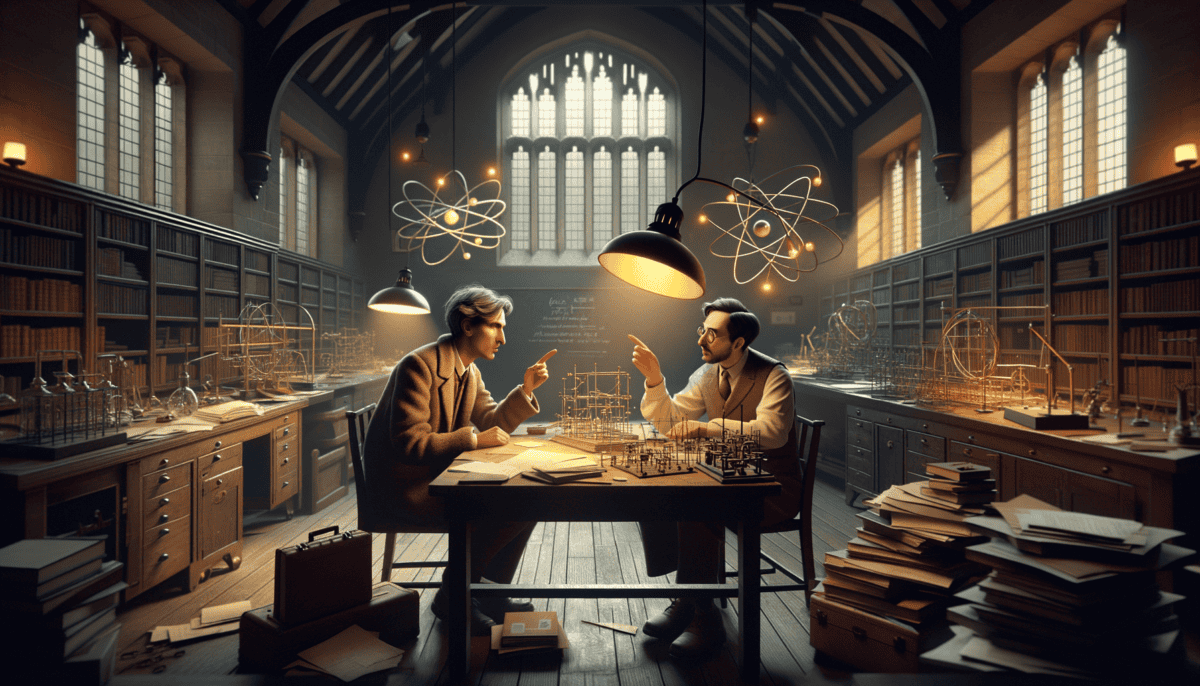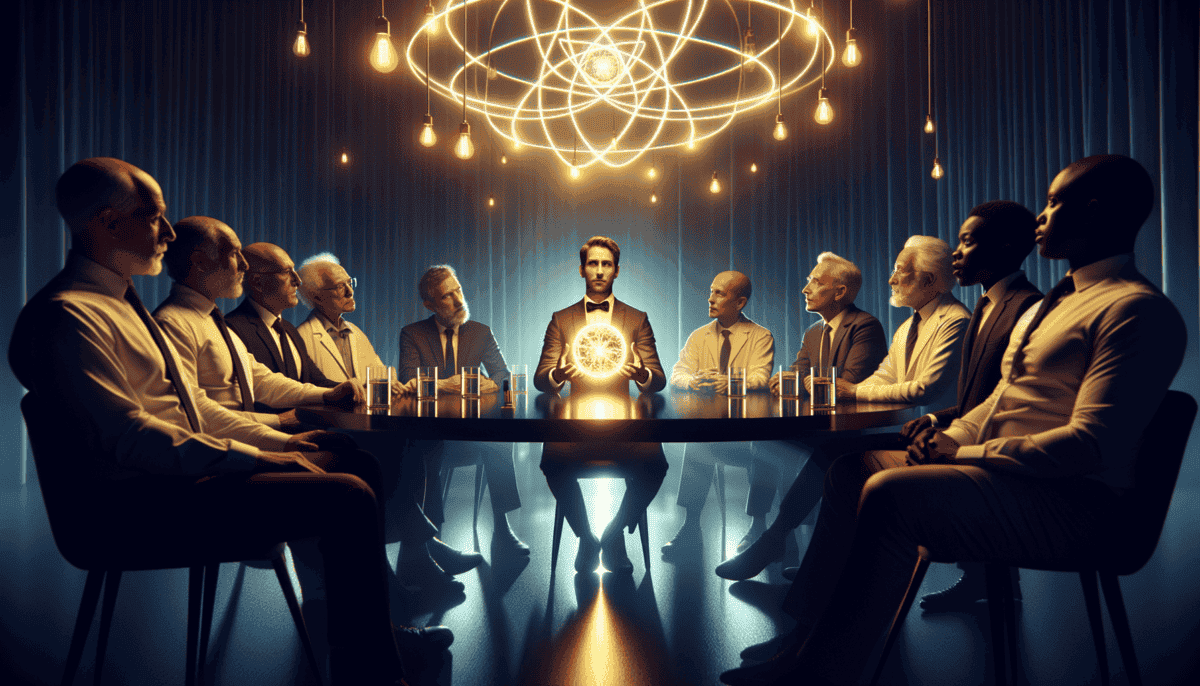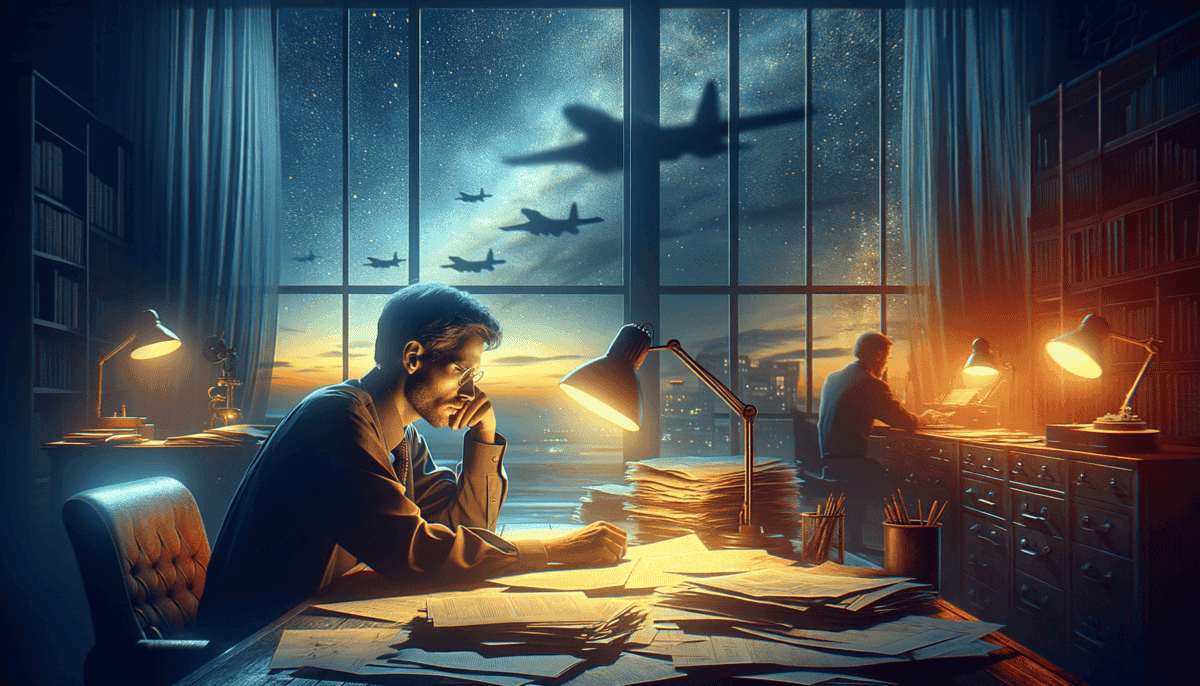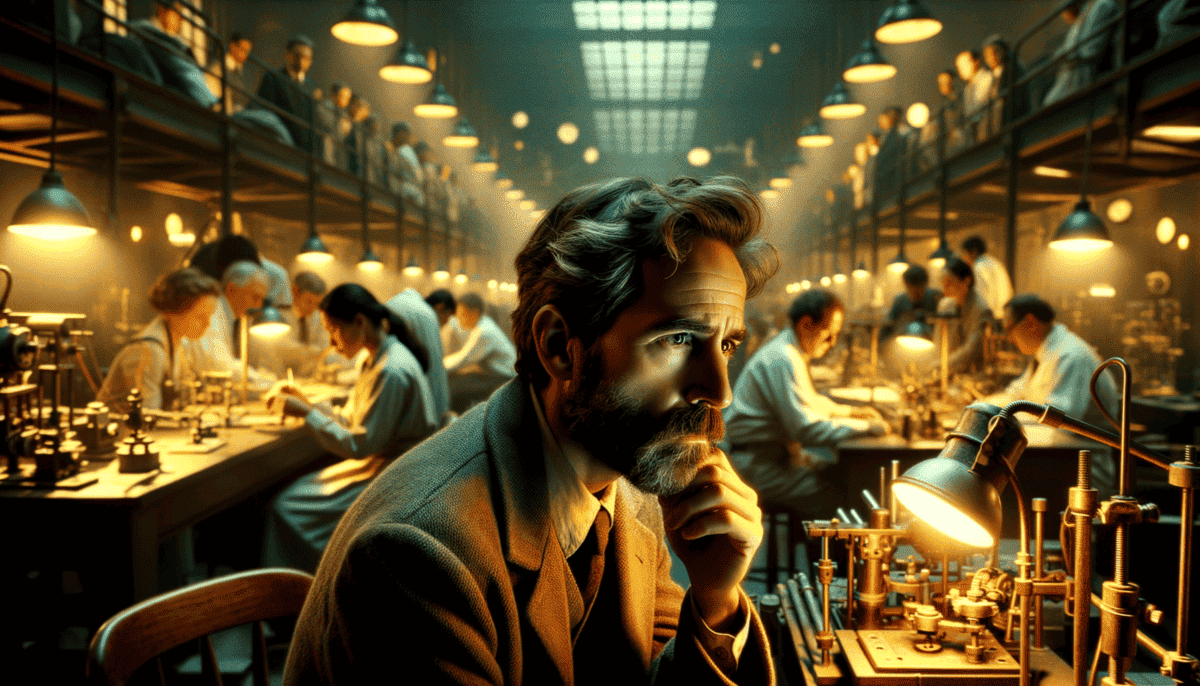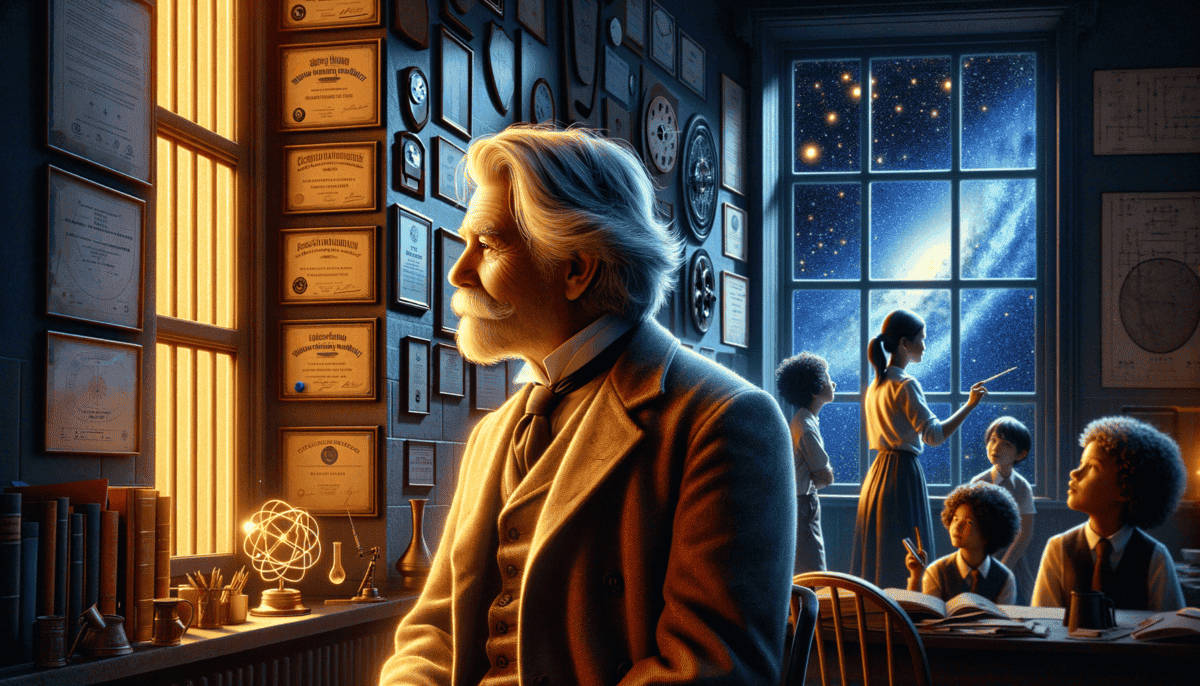The Curious Boy from Copenhagen
On a sunny morning in Copenhagen, a young boy named Niels kicked a soccer ball against the brick wall of his family's home. The ball bounced back with perfect timing, just like clockwork. Little did anyone know this playful child would grow up to change how we see the tiniest parts of our world.
"Niels, time for breakfast!" called his mother, Ellen. She smiled as her energetic son caught the ball one last time before running inside.
The Bohr family home buzzed with activity. Niels's father, Christian, a professor at the university, sat at the breakfast table reading a thick book. His younger brother Harald was already munching on warm bread.
"Papa, why does the clock tick?" Niels asked, pointing to the grandfather clock in the corner. His bright blue eyes sparkled with curiosity.
Christian looked up from his book and smiled. "That's an excellent question, my boy. Would you like to take it apart and see?"
That afternoon, father and son carefully opened the clock's wooden case. Niels watched in wonder as his father showed him all the tiny gears and springs working together.
"Everything in our world is made of smaller parts working together," Christian explained. "Just like this clock."
A Special Discovery
One rainy afternoon, Niels found an old magnifying glass in his father's study. He spent hours looking at everything he could find:
• Leaves from the garden
• Drops of water
• Grains of sand
• The wings of a butterfly
• The pattern on his mother's tablecloth
"Mama!" he called out excitedly. "Everything looks different when you look very close!"
Ellen watched her son with pride. "You have special eyes, Niels. You see things others might miss."
School Days
At school, Niels's teachers noticed something special about him. He asked questions no one else thought to ask. While other students were happy with simple answers, Niels always wanted to know why things happened the way they did.
His favorite teacher, Mr. Hansen, often stayed after class to talk with him. "Niels, you have a gift," he said one day. "You don't just learn things – you think about them in new ways."
“The best ideas come from looking at old problems with new eyes.” – Mr. Hansen to young Niels
Even during soccer games, Niels's mind worked differently. As goalkeeper, he didn't just catch the ball – he figured out where it would go by watching how players moved their feet.
"It's like a puzzle," he told Harald. "Everything follows rules, even if we can't see them right away."
Dreams of Discovery
At night, Niels would sit by his window, looking up at the stars. He imagined all the secrets hiding in the world around him, waiting to be discovered. His mother found him there one evening, lost in thought.
"What are you thinking about, my curious boy?" she asked.
"I want to understand everything, Mama," he replied. "How the stars shine, why the wind blows, what makes everything work the way it does."
Ellen hugged her son. "Then that's what you'll do, Niels. That's exactly what you'll do."
The boy who loved soccer and science grew more curious every day. His questions got bigger, and his dreams grew stronger. No one knew then that this thinking boy from Copenhagen would one day help us understand the tiniest building blocks of everything in our universe.
As Niels fell asleep that night, the ticking of the grandfather clock seemed to whisper secrets about a future filled with amazing discoveries.
Breaking the Atomic Rules
The ship rocked gently as Niels Bohr watched Denmark’s coastline fade into the distance. At twenty-six years old, he was heading to England to work with the famous scientist J.J. Thomson.
“I wonder what secrets we’ll discover,” Niels whispered to himself, clutching his notebook filled with ideas.
Meeting a Science Hero
Cambridge University looked like a castle from a fairy tale. Niels walked through its giant wooden doors, his heart beating fast. He was about to meet J.J. Thomson, the man who discovered electrons!
“Welcome to Cambridge, young man,” Thomson said with a friendly smile. “I hear you have some interesting ideas about atoms.”
Niels nodded eagerly. “Yes, sir! I think electrons might not behave the way we think they do.”
A New Way of Thinking
In Thomson’s laboratory, Niels spent many days watching how atoms behaved. Something wasn’t adding up. The old rules didn’t explain what he saw.
“Sometimes, to find the truth, we need to forget everything we think we know.” – Niels Bohr
One night, while watching a soccer match, Niels had a brilliant idea. He saw how players could only stand in certain spots on the field. What if electrons were like that too?
The Big Discovery
“Electrons jump!” Niels announced one morning, bursting into Thomson’s office. “They don’t move smoothly – they jump from one energy level to another, like players changing positions on a field!”
Thomson looked confused. “That’s impossible, Bohr. Electrons must follow the regular rules of motion.”
But Niels knew he was onto something special. He drew his new model of the atom:
- The center (nucleus) was like a soccer ball
- Electrons moved around it in special paths
- Electrons could jump between these paths
- When they jumped, they gave off light
- This explained why different materials glowed with different colors
Standing Up for New Ideas
“This is very different from what we believe,” other scientists said. But Niels stood firm.
“Look at the evidence,” he would say, showing them his careful notes and drawings. “Nature is telling us something new!”
A Breakthrough Moment
Finally, after months of work, Niels proved his ideas were right. His model explained things that no other theory could.
“It’s like solving a giant puzzle,” he wrote to his brother Harald. “Each piece helps us see the bigger picture more clearly.”
Other scientists began to see that Niels was right. His new way of thinking about atoms would change science forever.
As Niels looked out his window at Cambridge one evening, he smiled. The stars seemed brighter now that he understood more about how atoms worked. But he knew this was just the beginning of an even bigger adventure in understanding our universe.
The Quantum World Unveiled
Niels sat at his desk, surrounded by papers covered in drawings of atoms. The sun was rising over Copenhagen, where he now had his own laboratory.
Making Big Ideas Simple
“How can I help people understand atoms?” Niels wondered. He looked out the window and saw children playing on a playground.
Suddenly, he had an idea! “Atoms are like a playground,” he told his students. “Electrons are like children who can only play on certain parts of the equipment – they can’t float in between!”
People started to understand his ideas better when he explained them this way.
Not Everyone Believes
“That’s not how atoms work!” some older scientists said. They didn’t like Niels’s new ideas.
“Sometimes the simplest explanation is the right one, even if it seems strange at first.” – Niels Bohr
But Niels knew he was right. Every experiment proved his ideas worked better than the old ones.
The World Takes Notice
Scientists from all over started coming to visit Niels. They wanted to learn about his quantum ideas.
“Show us how electrons jump!” they would say.
Niels would smile and grab his chalk. On the blackboard, he drew:
- Circles showing where electrons could be
- Arrows showing how they jumped
- Lines showing the light they made
- Numbers that proved everything worked
- Pictures that helped explain it all
Building Something New
Young scientists came from everywhere to work with Niels. His laboratory became like a school for quantum physics.
“We’re like explorers,” Niels told his team. “We’re finding new ways to understand the tiniest things in the universe.”
Making Waves in Science
Niels’s ideas helped create something called quantum mechanics. It was a whole new way of thinking about the world.
“Remember when people thought the Earth was flat?” he would ask. “Sometimes we have to change how we think about everything!”
Scientists started using Niels’s ideas to understand:
✨ Why stars shine
How rainbows form
What makes light bulbs work
⚡ How electricity moves through wires
A New Understanding
One evening, while walking home, Niels looked up at the stars. He thought about how his simple ideas about jumping electrons had changed how everyone saw the universe.
“The more we learn,” he said to himself, “the more amazing everything becomes.”
Back in his laboratory, a new set of questions waited. The quantum world still had many secrets to share, and Niels was ready to find them. But darker clouds were gathering over Europe, and soon science would face its greatest challenge yet.
War, Science, and Hard Choices
Dark clouds hung over Copenhagen. It was 1939, and Niels looked worried as he read the morning newspaper. War had come to Europe. ️
A Letter from America
One morning, Niels got a special letter. It came from a place called Los Alamos in America.
“Dear Dr. Bohr,” the letter said. “We need your help with a very important project.”
The letter was from J. Robert Oppenheimer. He wanted Niels to help build something very powerful – an atomic bomb.
A Big Decision
Niels sat in his garden, thinking hard. He loved using science to help people. But this was different.
“With great knowledge comes great responsibility,” Niels whispered to himself.
Journey to Los Alamos
After much thinking, Niels decided to go. He traveled across the ocean to America.
Los Alamos was in a desert. It looked very different from his home in Denmark:
- Tall mountains instead of flat land
- Hot sun instead of cool weather
- Cactus plants instead of trees
- Secret buildings everywhere
- Scientists working day and night
Meeting New Friends
At Los Alamos, Niels met Robert Oppenheimer. Robert was tall and smart, like a wizard of science. ♂️
“Welcome to the Manhattan Project,” Robert said with a smile that didn’t quite reach his eyes.
Hard Questions
Every day, Niels worked with other scientists. But at night, he couldn’t sleep. He kept thinking about what they were making.
“What will happen when we finish?” he asked Robert one day.
“We must win the war,” Robert answered quietly. “But after that… we must make sure science helps people, not hurts them.”
A Secret Worry
Niels started writing letters to world leaders. He wrote:
“Dear Leaders,
Science is very powerful. We must be careful how we use it.
We must work together to make the world better, not worse.
Please think about this carefully.”
Looking Forward
One evening, Niels and Robert walked in the desert. The sun was setting, painting the sky orange and purple.
“We can’t stop science,” Niels said. “But we can try to use it wisely.”
Robert nodded. “Maybe that’s the most important experiment of all.”
As stars began to appear in the desert sky, Niels thought about his laboratory back home. He wondered what the future would bring, and how their work here would change the world forever.
Racing Against Time
The sun beat down on Los Alamos as Niels walked to the laboratory. Today felt different. The whole team knew they were getting closer.
Morning Meeting
“Good morning, everyone,” Robert Oppenheimer said. His voice was tired but excited. “We’re making good progress.”
Niels looked around the room. All the scientists had dark circles under their eyes. Nobody was getting much sleep.
Working Together
Scientists from many countries worked side by side:
- Americans in blue coats
- British in brown jackets
- Europeans like Niels
- Young helpers learning from older scientists
- Everyone sharing their ideas
A Worried Talk
During lunch, Niels sat with his friend Edward.
“What do you think will happen?” Edward asked. “When it’s finished?”
“This is bigger than anything we’ve made before,” Niels answered softly. “We must be very careful.”
Writing Letters
Every evening, Niels wrote more letters. He wanted to tell people about being careful with science. ✉️
“Dear Friends,
We are making something very powerful.
We must think about how to use it wisely.
The whole world needs to work together.”
A Big Test
One hot morning, everyone gathered in the control room. They were going to test their work.
“Are you ready?” Robert asked.
Niels nodded, but his heart was beating fast.
After the Test
The test was bigger than anyone expected. Even Robert looked shocked.
“Now we must be more careful than ever,” Niels said.
Looking to Tomorrow
That night, Niels couldn’t sleep. He walked outside and looked at the stars.
“We have opened a new door,” he thought. “But what’s on the other side?”
He knew science would never be the same. And he knew he had to help people understand how to use it safely.
As the desert wind blew softly, Niels made a promise to himself. He would spend the rest of his life working for peace and helping people use science to make the world better.
A Legacy of Light
The morning sun streamed through Niels Bohr’s window in Copenhagen. He was older now, with gray hair, but his eyes still sparkled with curiosity.
A Special Day
“Grandpa, tell us about your discoveries!” his grandchildren begged. They sat at his feet, eyes wide with wonder.
“Well,” he smiled, “it all started with a question about tiny things we can’t see…”
Teaching the Next Generation
Students from all over the world came to learn from Niels. His institute in Copenhagen became a special place where young scientists could share their ideas.
“The best way to learn is to teach others,” Niels would say with a warm smile.
Honors and Awards
People everywhere knew about Niels’s work. They gave him special prizes:
- The Nobel Prize for helping understand atoms
- Medals from many countries
- Letters of thanks from scientists
- Special books about his ideas
- A place in science history books
Making Peace with Science
Niels worked hard to help people use science for good things. He traveled around the world, talking to leaders and scientists. ✈️
A Lasting Impact
Even today, scientists use Niels’s ideas to:
– Make better computers
– Help sick people get better
– Learn about stars and space
– Create new kinds of lights
The Final Chapter
One quiet evening in 1962, Niels sat in his favorite chair. He thought about his long journey from a curious boy to a world-famous scientist.
“Science is not just about finding answers,” he told his family. “It’s about asking good questions and working together.”
“The best questions lead to more questions, and that’s how we keep learning.”
A Never-Ending Story
Today, when scientists look at atoms or think about quantum physics, they remember Niels Bohr. His ideas helped us understand our world better.
In laboratories and classrooms around the world, new scientists follow in his footsteps. They ask questions, work together, and dream of new discoveries.
And somewhere, maybe right now, another curious child is looking up at the stars, wondering about the mysteries of the universe, just like young Niels did so many years ago. The story of discovery continues, brighter than ever. ⭐


